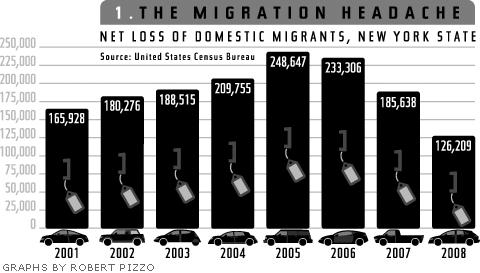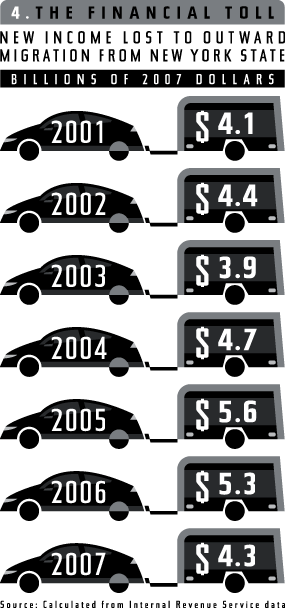New York State faces a host of economic and budgetary problems, as many of the stories in this issue make clear. One way of expressing the depth of these problems is through the state’s startling domestic-migration numbers. “Domestic migration” refers to people who move from one location to another within the United States. It takes into account migrants both into a state and out of it, subtracting immigrants from emigrants to yield the net number of people leaving a state. When that number is high, we can deduce that a state’s problems are prompting its residents to flee for friendlier locales.
From 2001 to 2008, New York lost more than 1.5 million domestic migrants—a larger loss than any other state’s (see Chart 1). That’s also the largest percentage loss of any state—more than 8 percent of New York’s 2000 population—even beating out Katrina-ravaged Louisiana. Among the many reasons for the hemorrhaging are the high taxes and heavy regulations that make New York one of the least business-friendly states, as well as high housing costs in the New York metropolitan region. Internal Revenue Service data indicate that the top destinations for New York’s domestic migrants were Florida, New Jersey, Pennsylvania, and North Carolina (Chart 2).
Finally, a reason to check your email.
Sign up for our free newsletter today.


Virtually every part of the state—from metropolitan New York City, which largely thrived until recently, to Buffalo, which is economically depressed—suffers from net domestic outmigration (Chart 3). The exception is the state capital, Albany, which experienced a gain, no doubt attributable to the effects of government, including public employment. Losses were concentrated in metropolitan New York City, which accounted for more than 1.3 million net domestic outmigrants—nearly 90 percent of the state’s loss. (Metropolitan New York City is defined as the New York State counties within the Census Bureau’s 30-county “New York Consolidated Area.”) Almost 11 percent of the metropolitan area’s 2000 population was lost to domestic migration, compared with less than 3 percent in the rest of the state.

Each year during this decade, the state has lost billions of dollars in people’s personal income as a result of domestic migration (Chart 4). With the exception of those emigrating from New York City’s suburbs, domestic migrants generally have higher incomes than New Yorkers who do not move. Not only is New York losing talented people to the rest of the country, then; it is also losing enormous financial resources at a time when it can least afford to.

